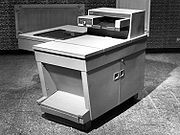
Xerox 914
Encyclopedia

Chester Carlson
Chester Floyd Carlson was an American physicist, inventor, and patent attorney born in Seattle, Washington....
's work on the xerographic process, the 914 was fast and economical. The copier was introduced to the public on September 16, 1959, in a demonstration at the Sherry-Netherland Hotel in New York, shown on live television
Live television
Live television refers to a television production broadcast in real-time, as events happen, in the present. From the early days of television until about 1958, live television was used heavily, except for filmed shows such as I Love Lucy and Gunsmoke. Video tape did not exist until 1957...
.
One of the most successful Xerox
Xerox
Xerox Corporation is an American multinational document management corporation that produced and sells a range of color and black-and-white printers, multifunction systems, photo copiers, digital production printing presses, and related consulting services and supplies...
products ever, a 914 model could make 100,000 copies per month (one copy every 26.4 seconds, or ~136 copies/hour). In 1985, the Smithsonian received a Xerox 914, number 517 off the assembly line. It weighs 648 pounds (294 kg) and measures 42" (107 cm) high x 46" (117 cm) wide x 45" (114 cm) deep.
The Xerox 914 was named because it could copy originals up to 9 inches by 14 inch
Inch
An inch is the name of a unit of length in a number of different systems, including Imperial units, and United States customary units. There are 36 inches in a yard and 12 inches in a foot...
es (229mm x 356 mm). The company's subsequent models were the 720, the 1000, the 813 and the 2400.
A floor-mounted device, the external design was created by James G. Balmer of Armstrong-Balmer & Associates, in collaboration with engineers Don Shepardson, John Rutkus and Hal Bogdenoff of Xerox, who had developed an engineering prototype.
One disadvantage of the Xerox 914 was that it had a tendency to catch fire when overheated (Ralph Nader
Ralph Nader
Ralph Nader is an American political activist, as well as an author, lecturer, and attorney. Areas of particular concern to Nader include consumer protection, humanitarianism, environmentalism, and democratic government....
claimed that a model in his office had caught fire three times in a four month period). Because of the problem, the Xerox company provided a "scorch eliminator", which was actually a small fire extinguisher, along with the copier.
Balmer had recently left Harley Earl, Inc., where he had been a designer since 1946, to co-establish Armstrong-Balmer & Associates in 1958. At Earl, Balmer had been involved in the Secretary copy machine designed for Thermofax and introduced by 3M in 1958, and Haloid Xerox had been impressed with the design, engaging Balmer to consult on the final design of the 914.
Xerography, a process of producing images using electricity, was invented in 1938 by physicist-lawyer Chester Floyd "Chet" Carlson (1906-1968), and an engineering friend, Otto Kornei.
Carlson entered into a research agreement with the Battelle Memorial Institute
Battelle Memorial Institute
Battelle Memorial Institute is a private nonprofit applied science and technology development company headquartered in Columbus, Ohio. Battelle is a charitable trust organized as a nonprofit corporation under the laws of the State of Ohio and is exempt from taxation under Section 501 of the...
in 1944, when he and Kornei produced the first operable copy machine. He sold his rights in 1947 to the Haloid Company, a wet-chemical photocopy machine manufacturer, founded in 1906 in Rochester, NY.
The first commercial xerographic copier, the Xerox Model A, was introduced in 1949 by Haloid, which had the previous year announced the refined development of xerography in collaboration with Battelle Development Corporation, of Columbus, OH. Manually operated, it was also known as the Ox Box. An improved version, Camera #1, was introduced in 1950.
Haloid had been re-named Haloid Xerox in 1958, and, after the instant success of the 914, when the name Xerox soon became synonymous with "copy", would become the Xerox Corporation.
In 1963, Xerox introduced the first desktop copier to make copies on plain paper, the 813. It also was designed by Jim Balmer and William H. Armstrong of Armstrong-Balmer & Associates, and won a 1964 Certificate of Design Merit from the Industrial Designers Institute (IDI).
A year later, in 1964, Balmer worked with Xerox to establish their first internal industrial design group. Among those first design employees were William Dalton and Robert Van Valkinburgh.

